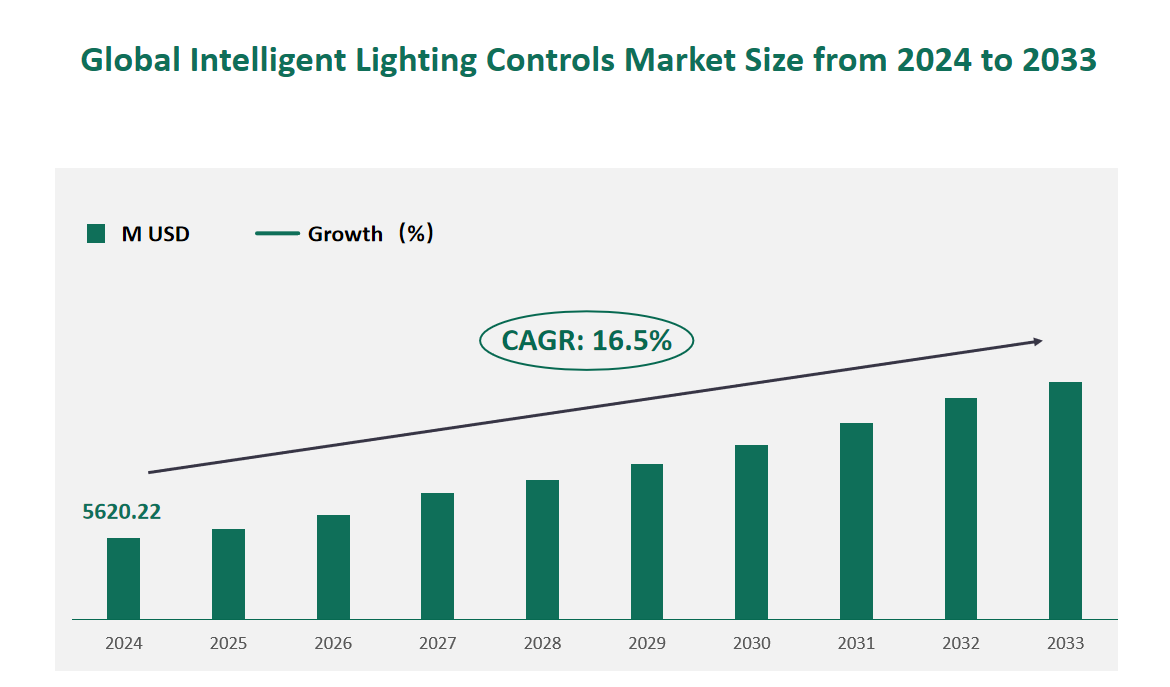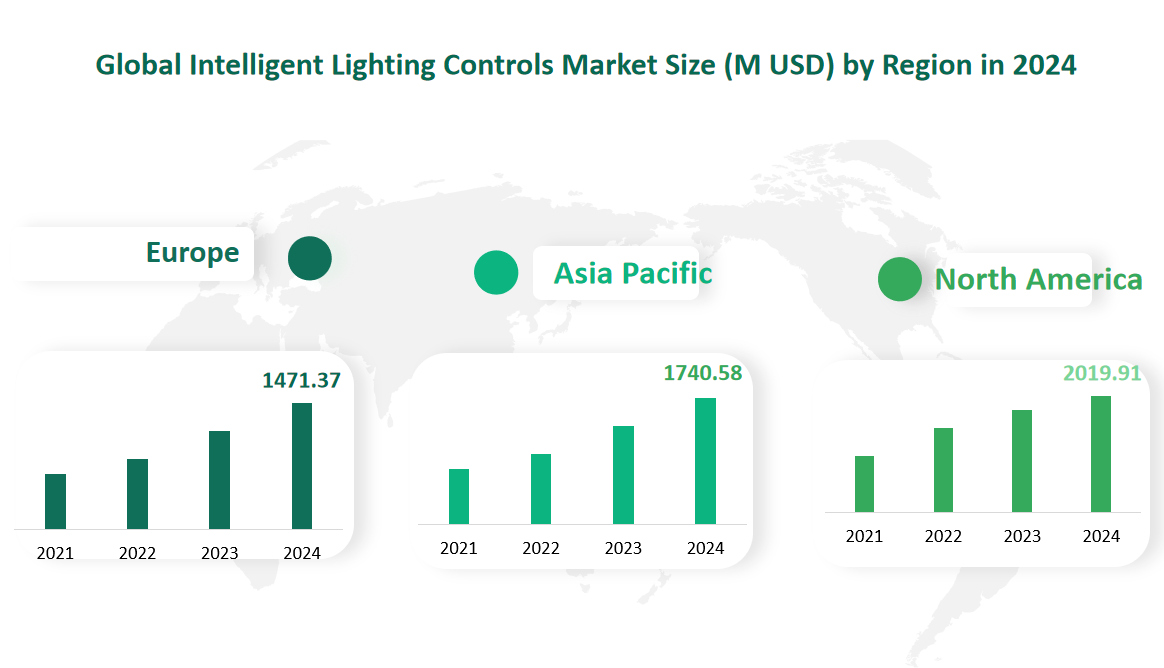1 Global Intelligent Lighting Controls Market Size (Value) and CAGR (2024-2033)
In 2024, the global Intelligent Lighting Controls market was valued at USD 5620.22 million, with a CAGR of 16.5% from 2024 to 2033.
Intelligent lighting control system is an automated technology, which comprises multiple lighting fixtures connected in a network to control lighting. Intelligent lighting control systems improve energy efficiency, performance, and customer value. A lighting control system is an intelligent network based lighting control solution that incorporates communication between various system inputs and outputs related to lighting control with the use of one or more central computing devices.
Smart lighting control system is a network-based lighting control solution that uses various components, such as occupancy sensors, transmitters & receivers, and microcontrollers, for controlling lighting. Lighting control systems are widely used on both indoor and outdoor lighting of commercial, industrial, and residential spaces. Lighting control systems serve to provide the right amount of light where and when it is needed. Lighting control systems are employed to maximize the energy savings from the lighting system, satisfy building codes, or comply with green building and energy conservation programs.
Figure Global Intelligent Lighting Controls Market Size (M USD) and CAGR 2024-2033

2 Intelligent Lighting Controls Market Drivers
Governments around the world are increasingly focusing on reducing CO2 emissions and promoting efficient energy consumption. Initiatives such as China’s five-year plan for energy efficiency projects and the European Union’s 2020 energy targets are driving the adoption of intelligent lighting controls. These systems ensure efficient use of electricity, minimizing wastage and contributing to sustainable energy management. For example, regions like the US, the UK, China, and India are implementing regulations that mandate the use of energy-efficient lighting solutions, thereby creating lucrative market opportunities.
The global push towards smart city development is a major driver for the Intelligent Lighting Controls market. Smart cities integrate advanced technologies to enhance urban living and reduce environmental impact. The Asia Pacific region, in particular, is witnessing significant growth in smart infrastructure, with China leading the way with over 800 smart city pilot programs. The US and India are also making significant strides, with projects like Intel’s Smart City Demonstration Platform in San Jose and India’s Smart City Mission, which aims to develop 100 smart cities. These initiatives are driving the demand for intelligent lighting controls, as they offer superior energy management and operational efficiency.
The market is further bolstered by the continuous decline in LED prices. Technological advancements have led to more efficient production processes, reducing the cost of LEDs while increasing their lifespan and performance. This trend has made LED lighting more accessible and affordable, encouraging widespread adoption. According to forecasts, LED prices are expected to continue dropping, making intelligent lighting control systems even more attractive to consumers and businesses alike. The cost savings associated with lower energy consumption and reduced maintenance further enhance the appeal of these systems.
3 Intelligent Lighting Controls Market Restraints
One of the primary restraints is the high initial cost associated with the installation of intelligent lighting controls. These systems require complex control mechanisms, sensors, and network infrastructure, which significantly increase upfront expenses. The average payback period for installing such systems can range from 2 to 3 years, which may deter some potential adopters. However, technological advancements and declining component costs are expected to reduce these initial costs over time, making the systems more affordable.
Wireless lighting controls, while offering significant flexibility and scalability, pose security and interference risks. Wireless systems communicate via radio waves, making them susceptible to hacking and signal interference. These concerns can limit the adoption of wireless lighting controls, especially in sensitive environments such as government buildings and critical infrastructure. Ensuring robust cybersecurity measures and improving signal reliability are crucial to overcoming these challenges.
4 Global Intelligent Lighting Controls Market Size by Type in 2024
Wired lighting controls are systems where all components are physically connected through wires. These systems are known for their reliability and robustness, making them ideal for applications where stability and precision are paramount. In 2024, the Wired segment is expected to account for a significant portion of the market, with a value of $2,788.19 million.
Wireless lighting controls use radio frequency (RF) signals to communicate between devices, offering greater flexibility and ease of installation. This segment is rapidly growing due to advancements in wireless technology and the increasing demand for smart home and smart city solutions. In 2024, the Wireless segment is projected to be valued at $2,832.03 million.
Table Global Intelligent Lighting Controls Market Size by Type in 2024
Type | Market Size (M USD) 2024 |
Wired | 2788.19 |
Wireless | 2832.03 |
5 Global Intelligent Lighting Controls Market Size by Application in 2024
In the realm of commercial buildings, the market value is projected to be $2,148.61 million in 2024. These controls are integral to enhancing energy efficiency and operational management in office spaces, retail centers, and industrial facilities. They offer advanced features such as occupancy sensors, daylight harvesting, and centralized control systems, which not only reduce energy consumption but also improve the comfort and productivity of occupants. The growth in this segment is driven by the increasing adoption of smart building technologies and government regulations that promote energy efficiency.
Residential buildings represent another significant segment, with a market value of $1,733.28 million in 2024. The adoption of intelligent lighting controls in homes is growing rapidly, driven by the increasing popularity of smart homes and the desire for energy savings. These controls provide convenience through remote control and scheduling, and they enhance security by integrating with other smart home devices. The market is propelled by the increasing disposable income of consumers and the growing awareness of the benefits of smart home technologies.
Public utilities, including street lighting and public spaces, are also a notable application area for intelligent lighting controls. The market value for this segment is expected to be $938.58 million in 2024. These controls focus on energy efficiency and operational savings, often featuring adaptive lighting, remote monitoring, and maintenance alerts. The market is driven by the need to reduce energy consumption and operational costs in public infrastructure, making it an essential component of smart city initiatives.
Table Global Intelligent Lighting Controls Market Size by Application in 2024
Application | Market Size (M USD) 2024 |
Commercial Buildings | 2148.61 |
Residential Buildings | 1733.28 |
Public Utilities | 938.58 |
Others | 799.76 |
6 Global Intelligent Lighting Controls Market Size by Region in 2024
North America leads the way with a market value of $2019.91 million in 2024. This region is characterized by high adoption rates of smart lighting solutions in both commercial and residential sectors, driven by strong technological infrastructure and supportive government policies that promote energy efficiency and smart city development.
Europe follows closely with a market value of $1471.37 million in 2024. The European market is distinguished by its focus on sustainability and energy efficiency, driven by stringent energy regulations and the increasing adoption of smart city initiatives. Countries like Germany, the UK, and France are at the forefront of implementing intelligent lighting controls in both public and private sectors.
The Asia Pacific region is experiencing rapid growth, with a market value of $1740.58 million in 2024. This growth is fueled by urbanization and the development of smart cities. Significant investments in smart infrastructure and the increasing adoption of LED lighting are driving the market. China and India are key markets, with substantial growth driven by government initiatives and private sector investments in smart lighting solutions.
Figure Global Intelligent Lighting Controls Market Size by Region in 2024

7 Major Players in Global Intelligent Lighting Controls Market
7.1 Legrand France SA
Company Profile:
Legrand France SA, established in 1860, is a global leader in electrical devices and systems. The company operates worldwide, offering a comprehensive range of products including switches, sockets, fuses, cables, security systems, and energy management components. Legrand is renowned for its commitment to innovation and sustainability, focusing on providing solutions that enhance energy efficiency and user experience.
Business Overview:
Legrand’s business is centered around designing and manufacturing high-quality electrical devices and systems. The company serves a diverse customer base, ranging from residential to commercial and industrial sectors. Legrand’s products are designed to meet the evolving needs of modern buildings, emphasizing energy efficiency and smart technology integration.
Product/Service Introduction:
Legrand offers a range of intelligent lighting controls, including the Wattstopper Digital Lighting Management system. This wireless lighting control solution allows for scalable and flexible lighting management, integrating daylight sensors, load controllers, and luminaire-level controls. The system can be programmed using the DLM Configuration App for iOS® or Android®, providing users with enhanced control and energy savings.
Recent Financial Performance:
In the most recent year, Legrand France SA reported a market value of $622.29 million.
7.2 Schneider Electric SE
Company Profile:
Schneider Electric SE, founded in 1836, is a multinational company specializing in energy and automation digital solutions. The company operates globally, addressing a wide range of sectors including homes, buildings, data centers, infrastructure, and industries. Schneider Electric is committed to providing efficient and sustainable solutions that enhance energy management and operational efficiency.
Business Overview:
Schneider Electric’s business encompasses a broad spectrum of energy technologies, real-time automation, software, and services. The company’s solutions are designed to optimize energy usage and promote sustainability across various applications. Schneider Electric’s extensive product portfolio includes intelligent lighting controls that integrate seamlessly with smart building systems.
Product/Service Introduction:
Schneider Electric offers the Powerlink Network Area Controller, a comprehensive solution for managing entire lighting systems. This controller features custom graphics, global time schedules, energy usage monitoring, and integration with third-party automation systems. The Powerlink system is highly flexible and can be upgraded to meet changing needs, providing a robust foundation for web-enabled control.
Recent Financial Performance:
In the most recent year, Schneider Electric SE reported a market value of $436.68 million.
7.3 OSRAM Licht AG
Company Profile:
OSRAM Licht AG, established in 1919, is a global leader in lighting solutions. The company operates worldwide, offering a diverse range of products including lamps, LEDs, lighting management systems, and specialty lighting solutions. OSRAM is known for its commitment to innovation and sustainability, focusing on delivering high-quality lighting products that enhance energy efficiency and user experience.
Business Overview:
OSRAM’s business is centered around manufacturing and distributing advanced lighting solutions. The company serves a wide range of customers, from residential to commercial and industrial sectors. OSRAM’s products are designed to meet the evolving needs of modern lighting applications, emphasizing energy efficiency and smart technology integration.
Product/Service Introduction:
OSRAM offers the DMX2DALI converter, a solution that integrates DALI/DSI-based dimming devices into DMX-controlled environments. This converter allows for seamless communication between external signals and e:cue systems, providing flexibility and scalability in building automation environments. The device supports easy and intuitive setup, making it an ideal solution for modern lighting installations.
Recent Financial Performance:
In the most recent year, OSRAM Licht AG reported a market value of $319.52 million.

